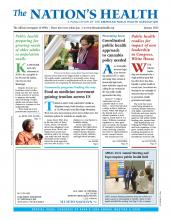
Photo by Moyo Studio, courtesy iStcokphoto
“Every community in America wants to support healthy aging.”
— Terry Fulmer
Kathy Burk took early retirement in 2019 to be a caregiver to her 90-year-old mother, who lives in rural Mississippi.
Despite 40 years as a front-line social worker, Burk said she was struck by the scarcity of services to improve the health and well-being of older adults and increase their chances to continue to live independently.
“Even with all of my professional experience, I struggled to find resources and support, and I was surprised by how many of my friends were in the same situation,” Burk, MSW, LCSW, former director of health services for the Mississippi State Department of Health, told The Nation’s Health. “You don’t think about it until you’re there.”
In 2020, Burk learned about a grant opportunity through Trust for America’s Health to help health departments improve their public health response to the needs of older adults and families. She reached out to her former colleagues at the Mississippi State Department of Health and urged them to apply.
Just three years after receiving the grant, Mississippi achieved TFAH’s prestigious Age-Friendly Public Health Systems “exemplar” status for its work to support the health of older adults and caregivers. TFAH’s recognition program is designed to highlight the efforts of state, local, tribal and territorial health departments around age-friendly initiatives. The need has never been greater.

Loyalty Litonjua, center, exercises during a group Zumba class at the Lorton Senior Center in Lorton, Virginia, in 2017. The center is part of a network that offers programs and activities for the county’s older adult population.
Photo by Evelyn Hockstein, courtesy The Washington Post/Getty Images
The U.S. population is older than it has ever been. A century ago, only about 1 in 20 Americans were ages 65 or older. Today, about 1 in 6 people, or 17% of the U.S. population, are 65 and above. By 2030, all the baby boomers will have reached age 65, bringing the number of older U.S. residents to 1 in every 5. And by 2034, for the first time in recorded history, the U.S. Census Bureau estimates that seniors will outnumber children younger than 18.
As the nation’s older adult population swells, public and private sectors around the U.S. are mobilizing, partnering and collaborating to ensure the availability of services and support that allow older adults to thrive. Public health leaders hail it as a national movement, with efforts ranging from the highest levels of the federal government to grassroots work in rural areas.
In May, the U.S. Department of Health and Human Services’ Interagency Coordinating Committee on Healthy Aging and Age-Friendly Communities — authorized by the Older Americans Act — released a landmark report to Congress on aging in the United States.
Developed by leaders and experts from 16 federal agencies and departments, the framework sets the groundwork for a coordinated effort on healthy aging. It calls on the private and public sectors to work in partnership with older adults, family caregivers and other stakeholders to support health and independence for older adults.
The federal framework encompasses affordable and accessible housing, transportation, age-friendly workplaces, improved access to long-term services and more.
“Ten years ago, public health was hardly doing anything around older adults,” Megan Wolfe, JD, senior policy development manager at TFAH, told The Nation’s Health.

Bruce Brandt, a retired physicist and a volunteer with the Harpswell Aging at Home community initiative in Maine, works on wiring at a senior’s home in 2018. Local and national programs are partnering to help seniors live healthily.
Photo by Derek Davis, courtesy Portland Press Herald/Getty Images
Wolfe credits former TFAH President and CEO John Auerbach with bringing the need to light. A decade ago, while traveling the nation giving presentations, Auerbach began noticing that people everywhere were talking about their personal struggles with caring for elderly loved ones. In partnership with the John A. Hartford Foundation and with support from public health, policymakers, the aging sector, health care systems and academia, TFAH developed its Age-Friendly Public Health Systems framework, which is based on six areas of age-friendly public health activities.
“We are trying to be the lead in this, but we are not experts in all the fields, either, so our leadership is really trying to just enhance collaboration and communication around this area,” Wolfe said, noting that work is happening across the U.S.
Mississippi’s journey to achieving recognition as an Age-Friendly Public Health System — which was highlighted in a recent issue of the Journal of Public Health Management and Practice — included establishing a cross-sectoral advisory committee, developing a statewide action plan, and partnering with a University of Massachusetts Boston team to create a healthy aging data report and county data profiles with more than 120 indicators across 82 counties. The county-specific population summaries have served as catalysts for action by documenting and quantifying the unmet needs of older adults in every county.
“It’s been absolutely amazing to see the level of appreciation for this work and the interest from a policy and equity lens,” said Kina White, DrPH, MHSA, director of the Mississippi Department of Health’s Office of Community Health Improvement. “We have several mayors who are now interested in becoming age- and dementia-friendly communities because of this work.”
Among its other achievements, the department developed partnerships with the Mississippi Public Health Association, AARP Mississippi, Area Agencies on Aging and faith communities to encourage age-friendly and intergenerational activities.
“Every community in America wants to support healthy aging,” said Terry Fulmer, PhD, RN, president of the John A. Hartford Foundation, a private organization helping to facilitate partnerships to help create Age-Friendly Public Health Systems and elevate healthy aging as a core public health function. “We’ve seen great bipartisan support across states ranging from Mississippi to Washington.”
In Washington state, the Department of Health partnered with local health jurisdictions, area agencies on aging and the Northwest Washington Indian Health Board, a six-tribe consortium, to develop action plans that include building emergency preparedness, using data to inform planning and expanding fall prevention partnerships.
Engagement with the tribal consortium provided the first opportunity for TFAH’s age-friendly framework to be implemented in a culturally and linguistically appropriate manner within a tribal elder community. Washington is also part of the Dementia Action Cooperative. In 2017, with encouragement and assistance from cooperative members, Washington applied for a small grant to work with the Association of State and Territorial Health Officials and the National Alzheimer’s Association. The work has focused on activities around the National Healthy Brain Initiative.
“It is so important to understand brain health and healthy aging through the life course, and to understand the role of public health,” said Marci Getz, MPH, director of healthy aging initiatives at the Washington State Department of Health.
The National Association of County and City Health Officials is also engaging health departments on a range of programs and activities, including work to enhance the education and training of local health departments to promote brain health and healthy aging through strategic partnerships and training initiatives. ASTHO’s healthy aging portfolio has expanded to support public health agencies through capacity building and technical assistance.
Back in Mississippi, Burk continues to be active in numerous organizations that support healthy aging.
“We’re not doctors and we’re not nurses, so we don’t have a prescription pad,” she said. “Our relationships become our prescription pad, because that’s what we use to connect and help people.”
For more, visit www.acl.gov/ICC-Aging and www.afphs.org.
- Copyright The Nation’s Health, American Public Health Association









